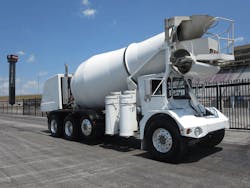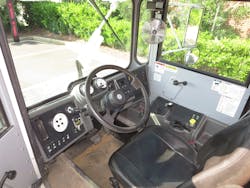Take a look at a trend in the concrete industry, or something that Terex Advance hopes will be a trend: The Charger front-discharge concrete mixer, a smaller and lighter version of the firm’s line of roadgoing, worksite-crawling, concrete-placement machines. Announced at World of Concrete in 2018, the Charger is a “city truck” designed to replace conventional rear-discharge trucks, and is slowly but steadily making sales inroads in regions where its simple three- or four-axle configuration makes sense, as we’ll hear from a man who sells it.
But first, let’s take a ride. We drove the truck last spring in Atlanta, which was beginning its annual climactic change to “Hotlanta.” The sun was heating up as my hosts showed me around the center-cab, mid-drum, rear-engine truck after I had taken a short airplane trip down from Ohio, where a sloppy and cold winter made my trip south more than welcome. At first the Georgia heat felt good, and it didn’t bother me at all as I climbed into the stark-white Charger demonstrator, cranked up its Cummins diesel, punched the Allison transmission into Drive, and followed Scott Rheinhold, Terex Advance’s marketing manager (who has since left the company for other endeavors) and Tom Pfingst, Advance’s Southeast regional sales manager, in their rental car.
Liberal axle-weight laws (bridge formula laws) in southeastern and northeastern states allow relatively high loads that the Charger can operate in, Pfingst said. The larger FD series, now called Commander, is usually fitted with multiple axles for use in bridge-formula states. The Charger’s frame is hefty, but less so than the larger trucks because one pusher axle is all it will get, though a booster axle is possible later. And, like most conventional mixers, there’s no heavy and expensive driving front axle. Details like those are what pares 3,000 to 4,000 pounds from the chassis and $25,000 or more from its price, yet it will still carry as much as 10.5 cubic yards of concrete. Its filler funnel is a foot or more lower than with a Commander, so a producer need not alter a plant to accommodate the Charger.
We headed out of a hotel parking lot and after some street running, turned onto another lot so the two could pick up some brochures at a shipping store. This gave me a chance to make some sharp turns and reverses, using D and R on the tranny’s keypad and spinning the smallish steering wheel like a real driver might do while maneuvering to where his concrete must be placed. Except that with this kind of truck, backing would be limited and he would drive right up to that spot, hop out to add a section or two or three to the chute, jump back inside, and begin the pour. That speeds things up and, because the driver’s moving forward where he can easily see, enhances safety on the site, where people are moving around close to the truck, Pfingst said. Yeah, but then he has to back out onto a road or street, I countered. But the road or street is likely to be a lot less congested, he answered. And I saw that the view rearward past the narrow drum is really pretty good.
The cab also is narrow, but plenty wide for the one person who’s driving, and accessing is easier than with the larger Commander. The Charger sits closer to the ground, making the steps less lofty, while their treads are just as wide and a foot or more deep. To fall you almost have to be trying. Once at the door, the well formed by the cab’s floor is shallower, so the driver need not do contortions to slip inside and onto the seat. Thus climbing in and out was easier than with the big FDB (forward-discharge with booster axle) model I drove back in 2013. The Charger was more nimble, but otherwise driving it was much the same: Get accustomed sitting over the center of a lane, be amused and pleased that diesel growling is way behind you and in-cab noise therefore low, and enjoy the good visibility in most directions.
The stainless steel cab is boxy, and there are a lot of metal members outside, including the mirrors, the chute in its stowed position, and the catwalk to the funnel, that ought to whistle in the wind. Yet there was surprisingly little noise as the truck, well, charged through the air at up to 65 mph on the highway. Air conditioning is optional but this cab didn’t have it, yet I don’t recall being overly warm. There was a fan on the A-pillar to the right and manual cranks for the side windows were close at hand, so there was ample air movement. Another pleasant surprise was a rather smooth ride, even with no load in the drum, thanks to air-bags over the tandem drivers and multi-leafs over the steer axle, both suspensions from Hendrickson.
With no load, performance was snappy. The midrange-size, heavy-duty Cummins revved easily and the Allison automatic shifted smoothly and appropriately. With 380 horses, this machine could get up and go, and I had no trouble keeping up with traffic. The open road is not this truck’s intended operating venue—it’s a city truck, remember—but freeways are part of most modern cityscapes, and the Charger felt very much up to higher-speed cruising. This was on southbound Interstate 75 and U.S. 41, where on a Saturday morning traffic was sparse as we headed to the Atlanta Motor Speedway. In its infield a roadeo was being staged for drivers of ready mix trucks. This was the Georgia portion of an annual countrywide competition sponsored by the National Ready Mix Concrete Producers Association. In it, trucks move slowly on paths and past obstacles marked by orange cones—nothing like NASCAR races the speedway was built to host, but I appreciated the drivers’ professionalism and admired the support shown by their families who were present to watch.
Fleets provided both front- and rear-discharge mixers for drivers to use and the Charger stood out for its compactness, though its overall size was about the same as several 10-wheel conventional units on hand. And that’s its point: Limited in size but with a useful carrying capacity, a Charger can do a job quicker and at a price comparable to the conventional trucks that many fleets are using now. Pfingst said that if operators can get past what they’ve always used and open their minds to something different, they stand to gain productivity and, in most cases, extra revenue. So the idea and the truck are out there. Take a look.






